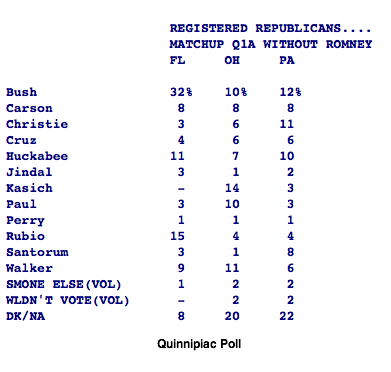
Early 2016 primary polling shows a wide-open Republican race. We weigh in on the pollster debate about the 'margin of error.' And social media platform use varies by race. This is HuffPollster for Wednesday, February 4, 2015.
NEW EARLY PRIMARY POLLS IN FL, OH & PA - Quinnipiac University: "Former Florida Gov. Jeb Bush is emerging as the Republican front-runner in an early look at possible presidential primaries in the critical swing states of Florida, Ohio and Pennsylvania, but even with Mitt Romney out of the race, Gov. Bush's only clear dominance is in his native Florida, according to a Quinnipiac University Swing State Poll released today. In contrast, former Secretary of State Hillary Clinton is the choice of more than 50 percent of Democrats in each state...The Swing State Poll focuses on Florida, Ohio and Pennsylvania because since 1960 no candidate has won the presidential race without taking at least two of these three states. 'Mitt Romney's withdrawal from the presidential race, at first blush, has no statistical benefit in Florida, Ohio or Pennsylvania for any candidate for the Republican presidential nomination,' said Peter A. Brown, assistant director of the Quinnipiac Poll.'" [Quinnipiac]
Not so fast... - In recent weeks, HuffPollster has pointed to a chorus of recommendations to ignore early trial heat polling because of its lack of predictive accuracy. Those columns have focused mainly on general election match-ups between Democratic and Republican candidates, but similar advice applies to early presidential primary measurements, particularly those in states that hold their primaries toward the middle or end of the primary season. The Florida and Ohio primaries will likely occur in March 2016, and Pennsylvania in April, following earlier contests in Iowa, New Hampshire, South Carolina and other states that will narrow the field and likely scramble whatever candidate preferences exit beforehand. The results of the Quinnipiac polling show no clear leader outside of Florida, and even there, home state favorite Jeb Bush is currently the choice of just 32 percent of registered Republicans. For now, the trial-heat polling alone suggests a wide open GOP race.
THE 'MARGIN OF ERROR': WHAT IT IS AND WHAT IT ISN'T - HuffPollster and HuffPost Data Scientist Natalie Jackson: "[P]ollsters disagree fiercely about when [the term 'margin of error'] should be used...Last week… polling experts got together to argue whether a margin of error should ever be reported for surveys conducted online -- which is how more and more surveys are conducted...Over the years, the margin of sampling error has typically been provided to give readers a sense of a poll's overall accuracy…That simple idea requires some critical assumptions, however: It presumes that the sample was chosen completely at random, that the entire population was available for sampling and that everyone sampled chose to participate in the survey. It also assumes that respondents understood the questions and that they answered in the desired way...In the real world, these assumptions are never fully satisfied…According to one academic study, even scientists and research professionals often wrongly interpret the margin of error to be an estimate of all possible error in polling data. It's not surprising the general public makes the same mistake."
Our dilemma - "In recent years, the American Association for Public Opinion Research has waded into this controversy, recommending against the reporting of a margin of error for opt-in surveys...This ongoing debate creates a dilemma for The Huffington Post's reporting of results from the opt-in online panel surveys we conduct in partnership with YouGov. Although YouGov calculates a "model-based margin of error" for each survey, we have not been reporting it when we discuss the survey results in HuffPost....The problem: If we cite YouGov’s margin of error, we violate AAPOR's Code of Ethics. If we leave out the margin of error, however, we fail to offer readers guidance on the random variation that's present with this type of survey, which we believe is also an ethical lapse. As members and proponents of AAPOR, we consider neither situation satisfactory. And the margin of error does offer valuable information when you're comparing two results from a survey or surveys -- it tells you how large differences have to be in order to mean something." [HuffPost]
REPORTING ON POLLS 'COULD STILL BE BETTER' - NYU political scientist Nathan Beck reacts to the detailed side-bar accompanying New York Times poll stories that explains "how the poll was conducted:" "[O]n first reading I was ecstatic to see such details. I do not know when newspaper polls started telling people that sampling error is hardly the only source of uncertainty, but I was pleased to see it...But, alas, ecstasy is often short-lived. So on re-reading, I was surprised to see no mention of the response rate for the poll. I know response rates are low, but I was curious. I wrote to Michael Kagay, who was listing as assisting the Times on the poll. Shockingly, he replied (on a Saturday) in under an hour...[T]he Times is to be congratulated on providing so much detail, and Michael Kagay doubly so for providing the relevant information...But why was not the most important statistic of the operation (after the sample size) not even mentioned?" [WashPost]
SOCIAL MEDIA USE BROKEN DOWN BY RACE - Jens Manuel Krogstad: "Today, about eight-in-ten Latino, black and white adults who are online use at least one of five social media sites – Facebook, Instagram, Pinterest, LinkedIn and Twitter. Among these, Facebook stands out as the most widely used platform, regardless of race or ethnicity: About seven-in-ten adult internet users (71%) say they use the site. But there are differences by race and ethnicity in the use of other social media sites, in particular Instagram. The photo-sharing site is more popular among Hispanic and black internet users than among white internet users. About one-third (34%) of online Hispanics use Instagram, as do 38% of blacks. By comparison, only 21% of whites use the network." [Pew]
HUFFPOLLSTER VIA EMAIL! - You can receive this daily update every weekday morning via email! Just click here, enter your email address, and click "sign up." That's all there is to it (and you can unsubscribe anytime).
WEDNESDAY'S' OUTLIERS' - Links to the best of news at the intersection of polling, politics and political data:
-Gallup's monthly economic confidence score is positive for the first time since the recession. [Gallup]
-Americans and scientists agree more on vaccination than on other issues. [538]
-Hillary Clinton's pollster finds support for her among millennials.
[Fusion]
-Gene Ulm (R) attributes Obama's rising popularity to falling gas prices. [POS]
-Sean Trende ponders what the new John Judis analysis means for "The Emerging Democratic Majority." [RCP]
-Americans still love NASA. [Pew]
-Iowa's GOP caucus voters are not big fans of Beyonce. [HuffPost]
-Vox maps the nation's coffee preferences. [Vox]

